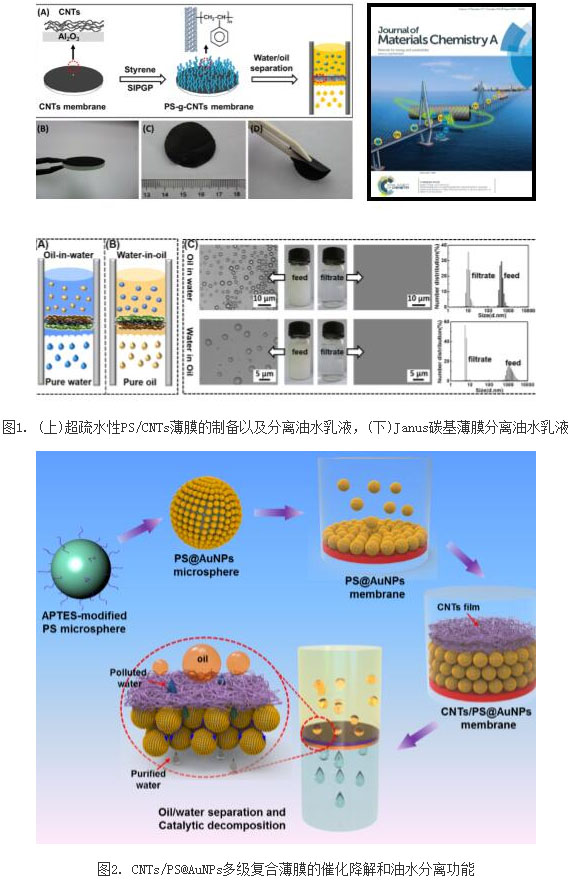Offshore crude oil leakage and the generation of large amounts of oily wastewater in industrial processes such as petrochemicals, machinery, leather, textiles, etc., lead to oils entering the water body through various means. In order to protect ecological balance and human health and protect limited water resources, effective separation of oily wastewater is necessary. Composite materials with special surface wettability can easily and effectively achieve oil-water separation. However, most of these materials can only be separated from oil-water mixtures, and cannot effectively separate oil-water emulsions, especially surfactant-based oil-water emulsions. In addition, oily wastewater often contains microorganisms such as organic pollutants or harmful bacteria. The water quality after separation of oil and water cannot be directly discharged into the water system. Currently, there is no effective means to purify the separated oily wastewater. Therefore, the construction of a new type of oil-water separation material and the effective separation of oil wastewater, and the realization of the purification of water quality are of great significance to the protection of the ecology.
The intellectual polymer team led by Chen Tao, a researcher of Polymer Division of the Ningbo Institute of Materials Technology and Engineering, Chinese Academy of Sciences, has long devoted himself to the study of two-dimensional macromolecule nanocomposite oil-water separation materials through surface-grafted polymer brushes and multi-stage assembly technologies. Get a variety of new composite materials, can achieve efficient separation of oil and water emulsions and water purification. Researchers used porous ceramics as a substrate, suction-filtered carbon nanotubes (CNTs) to form a film, and used self-initiated photografting and photopolymerization (SIPGP) to graft hydrophobic polymer benzene. On the surface of ethylene (PS) to CNTs, a high-roughness surface of the CNTs film was used synergistically to obtain a superhydrophobic two-dimensional hybrid film material. The membrane can be used for high-throughput, high-efficiency separation of micro- and nano-scale water-in-oil emulsions (J. Mater. Chem. A, 2014, 2, 15268-15272, Figure 1, top, inside cover). On this basis, the obtained superhydrophobic PS/CNTs film was reversed and transferred to another substrate, and the hydrophilic polydimethylaminoethyl methacrylate (PDMAEMA) was unidirectionally grafted again through SIPGP. On the surface of the CNTs film, a double-sided (Janus) composite film (PDMAEMA/CNTs/PS) having a hydrophilic/hydrophobic structure was obtained to achieve the effect of selective separation of water-in-oil and oil-in-water emulsions (ACS Appl. Mater. Interfaces, 2014, 6, 16204, Figure 1 below). In response to the problem of non-corrosive corrosion of existing oil-water separation materials, the team grafted and modified the surface energy of perfluorodecyltriethoxysilane (PFDTS) on the surface of CNTs, thereby facilitating the preparation of PFDTS with controllable morphology and flow rate. /CNTs film for efficient and rapid emulsified oil-water separation. The film has good acid and alkali resistance, high temperature resistance, low temperature and flame retardant properties, and lays a good foundation for improving the practicality of oil-water separation materials (J. Mater. Chem. A, 2015, 3, 4124).
In order to remove harmful pollutants in oily wastewater quickly and effectively, the team obtained a new type of multi-stage composite material through surface grafting molecular brush and layer assembly technology to achieve efficient separation of oil-water emulsions and purification of water quality. Using the method of suction filtration, high-density polystyrene nanocomposite polystyrene composite microspheres (PS@AuNPs) are closely packed to form a composite microsphere catalytic film, and then a hydrophilic carbon nanotube film is deposited on the microsphere film. The surface, thereby obtaining an underwater superoleophobic and catalytically functional multi-stage composite film (J. Mater. Chem. A, 2016, 4, 10810, Fig. 2). During the separation process, the oil phase is intercepted by the upper carbon nanotube film, and the water phase passes through the lower layer composite microsphere film through the curved channel between the microspheres to achieve the oil-water separation function. While the aqueous phase passes through the pores of the microspheres, the model organic contaminants (nitrophenol and sodium borohydride mixed solution) in the aqueous phase are in full contact with the high-density gold nanoparticles on the inner wall of the pores, and are rapidly catalytically decomposed to achieve rapid and effective Catalytic degradation of organic pollutants in water. This new composite membrane material, for the first time, achieved simultaneous separation of oil-water emulsions and catalytic decomposition of water-soluble organic pollutants, with a throughput of 3500 L m-2 h-1 bar-1, a catalytic efficiency of up to 92.6%, and good The mechanical and catalytic stability can be reused multiple times and is suitable for continuous operation, providing a new separation technology for industrialized wastewater treatment. When silver nanoparticles (Ag NPs) are loaded into ultra-hydrophilic CNTs separation membranes, the bactericidal properties of silver nanoparticles can be used to kill organic contaminants or bacteria in the water while separating the oil and water (RSC Adv., 2016, 6 , 73399-73403), to achieve simultaneous oil-water separation and rapid and effective purification of water quality.
The above work was supported by the National Natural Science Foundation of China (51303195, 21304105), the Zhejiang Provincial Outstanding Youth Fund (LR14B040001), the Natural Science Foundation of Ningbo (2014A610127, 2015A610022), the Open Project of the Key Laboratory of Marine New Materials and Applied Technology of the Chinese Academy of Sciences (2016Z01), and Funding for projects such as the Zhejiang Provincial Philanthropy Technology Application Research Project (2015C33031).

Gabion Wire,Gabion Wire Mesh,Gabion Mesh,Vidaxl Gabion
ANPING HONGYU WIREMESH CO.,LTD , https://www.hongyufence.com